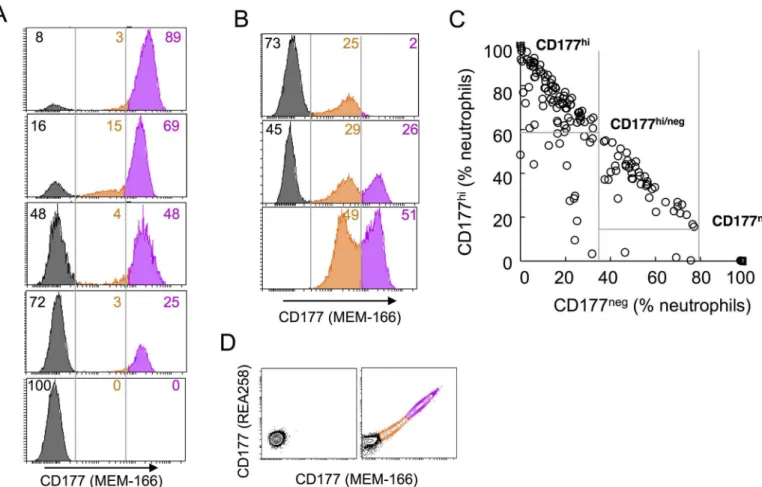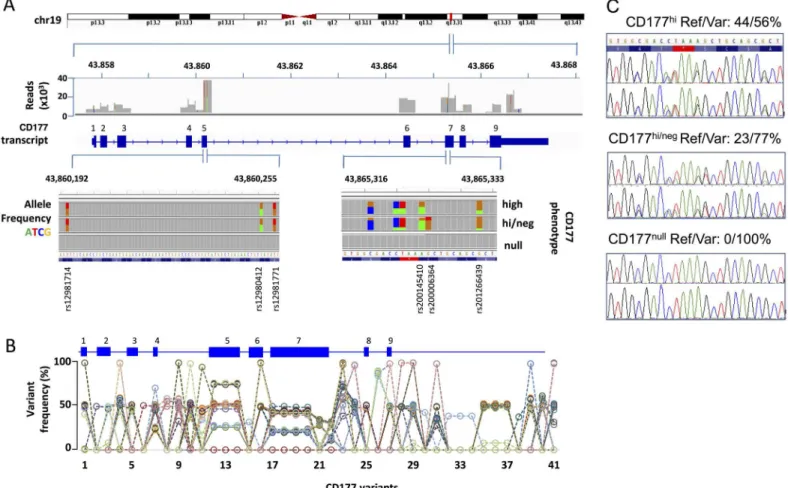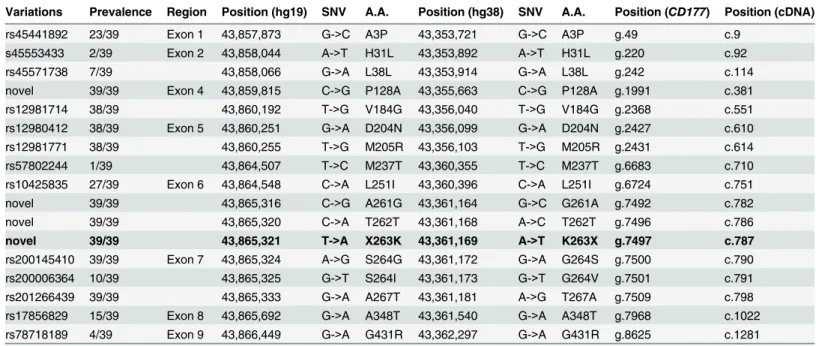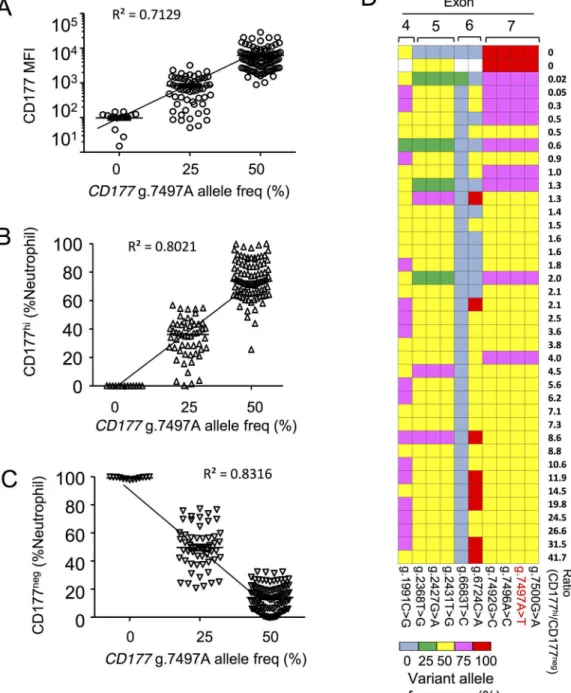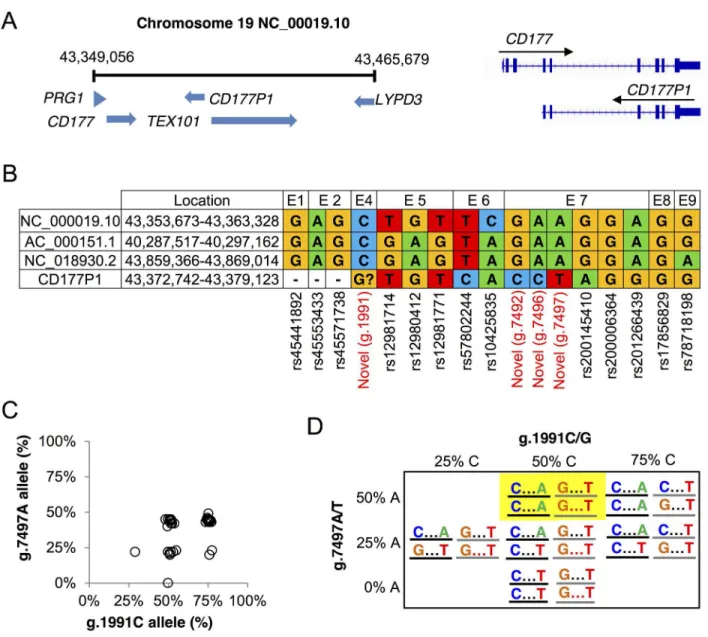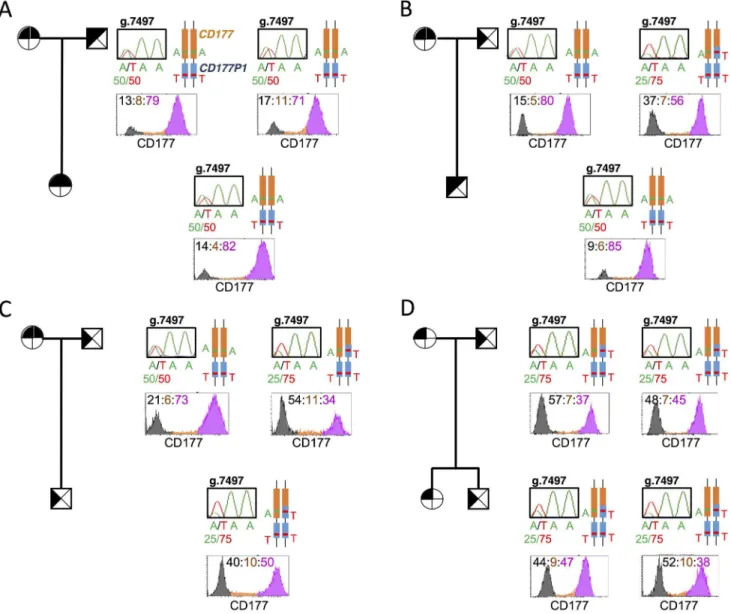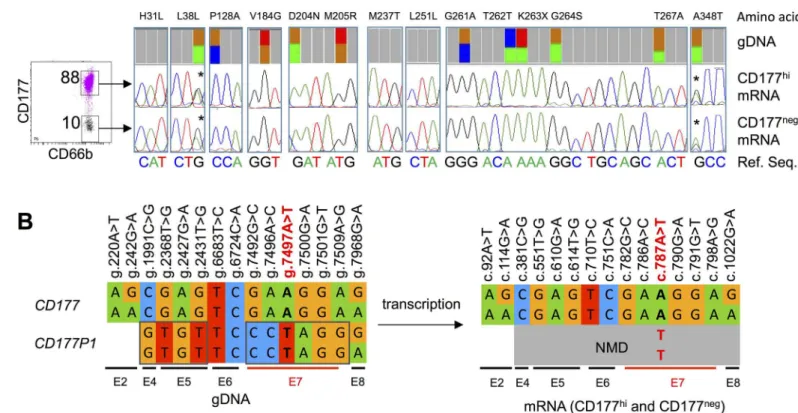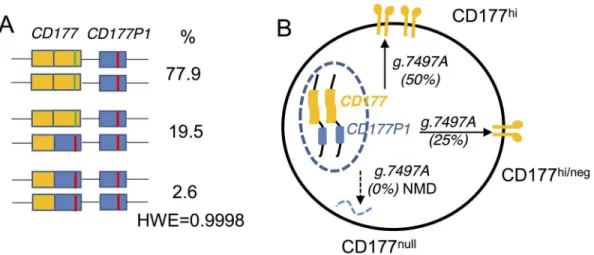Heterogeneity of Human Neutrophil CD177
Expression Results from
CD177P1
Pseudogene Conversion
Zuopeng Wu1,2, Rong Liang3, Thomas Ohnesorg4, Vicky Cho5, Wesley Lam1, Walter P. Abhayaratna2, Paul A. Gatenby6, Chandima Perera7, Yafei Zhang3, Belinda Whittle3, Andrew Sinclair4, Christopher C. Goodnow5, Matthew Field5, T. Daniel Andrews5, Matthew C. Cook1,5,6*
1Translational Research Unit, Canberra Hospital, Woden, Australian Capital Territory, Australia,2Clinical Trials Unit, Canberra Hospital, Woden, Australian Capital Territory, Australia,3Australian Phenomics Facility, Australian National University, Australian Capital Territory, Australia,4Murdoch Children’s Research Institute, Department of Paediatrics, The University of Melbourne, The Royal Children's Hospital, Melbourne, Victoria, Australia,5Department of Immunology, The John Curtin School of Medical Research, Australian National University, Acton, Australian Capital Territory, Australia,6Department of Immunology, Canberra Hospital, Woden, Australian Capital Territory, Australia,7Department of Rheumatology, Canberra Hospital, Woden, Australian Capital Territory, Australia
*Matthew.Cook@anu.edu.au
Abstract
Most humans harbor both CD177negand CD177posneutrophils but 1–10% of people are CD177null, placing them at risk for formation of anti-neutrophil antibodies that can cause trans-fusion-related acute lung injury and neonatal alloimmune neutropenia. By deep sequencing
theCD177locus, we cataloguedCD177single nucleotide variants and identified a novel stop
codon in CD177nullindividuals arising from a single base substitution in exon 7. This is not a mutation inCD177itself, rather the CD177nullphenotype arises when exon 7 ofCD177is
sup-plied entirely by the CD177 pseudogene (CD177P1), which appears to have resulted from allelic gene conversion. In CD177 expressing individuals theCD177locus contains both
CD177P1andCD177sequences. The proportion of CD177hineutrophils in the blood is a
her-itable trait. Abundance of CD177hineutrophils correlates with homozygosity forCD177
refer-ence allele, while heterozygosity for ectopicCD177P1gene conversion correlates with increased CD177negneutrophils, in which bothCD177P1partially incorporated allele and
paired intactCD177allele are transcribed. Human neutrophil heterogeneity for CD177 expression arises by ectopic allelic conversion. Resolution of the genetic basis of CD177null
phenotype identifies a method for screening for individuals at risk of CD177 isoimmunisation.
Author Summary
Expression of the neutrophil-specific antigen CD177 varies across the population. 1–10% of humans are CD177null. CD177posneonates born to CD177nullmothers are susceptible to alloimmune neutropenia. Interestingly, CD177posand CD177negpopulations of
a11111
OPEN ACCESS
Citation:Wu Z, Liang R, Ohnesorg T, Cho V, Lam W, Abhayaratna WP, et al. (2016) Heterogeneity of Human Neutrophil CD177 Expression Results from
CD177P1Pseudogene Conversion. PLoS Genet
12(5): e1006067. doi:10.1371/journal.pgen.1006067
Editor:Giorgio Sirugo, Ospedale San Pietro Fatebenefratelli, ITALY
Received:January 7, 2016
Accepted:April 28, 2016
Published:May 26, 2016
Copyright:© 2016 Wu et al. This is an open access article distributed under the terms of theCreative Commons Attribution License, which permits unrestricted use, distribution, and reproduction in any medium, provided the original author and source are credited.
Data Availability Statement:All relevant data are within the paper and its Supporting Information files.
neutrophils often exist together within individuals. The reasons for heterogeneous CD177 expression are not well understood. We deep sequenced theCD177locus in individuals with different levels of CD177 expression, cataloguedCD177single nucleotide variants, and identified a premature stop codon that causes lack of CD177 expression. Comparison of messenger RNA from neutrophils with genomicCD177DNA identified significant sequence similarity withCD177P1pseudogene, which probably explains existing misan-notation in public databases, but also explains susceptibility to cross-over errors. Indeed, we report that the stop codon responsible for the CD177nullphenotype arises when exon 7 ofCD177gene is supplied entirely byCD177P1by gene conversion. We also show that the proportion of CD177hineutrophil numbers within individuals is a heritable trait, deter-mined by the proportion of intactCD177and convertedCD177alleles. Furthermore, within individuals,CD177gene is differentially transcribed in CD177negand CD177hi neu-trophils. Our work resolves the genetic basis of CD177 phenotype and identifies a method for screening individuals at risk of CD177 isoimmunisation.
Introduction
CD177 (also known as neutrophil specific antigen B1 [NB1], human neutrophil antigen 2a [HNA-2a], and polycythemia rubra vera 1 [PRV1]) is a 56–64 kDa protein belonging to the Ly-6 family [1,2], and is expressed exclusively on neutrophils by glycosylphosphatidylinositol (GPI)-linkage [3,4]. CD177 expression is heterogeneous within the human population. 1–10% of people are CD177null, while the remainder harbor neutrophils that are bi- or tri-modal for CD177 expression [4–6].
Heterogeneity for neutrophil surface antigen expression within the population results in susceptibility to alloantibody formation due to loss of acquired immunological tolerance. Transplacental passage or transfusion of neutrophil antibodies have been implicated in severe neonatal alloimmune neutropenia (NAN) [7] and transfusion related acute lung injury (TRALI) [8,9]. Polymorphic human neutrophil antigens (HNA) include CD16 or FcγRIIIb (HNA-1a, -1b, -1c and -1d, encoded byFCGR3B) [10], CD177 (HNA-2a, encoded byCD177) [11,12], choline transporter-like protein 2 (HNA-3a) [13–15], CD11b (HNA-4a) and CD11a (HNA-5a) [16–19]. In some cases, the genetic polymorphisms that account for alloantigenicity have been resolved. For example, three separate alleles ofFCGR3B(designated HNA-1a, -1b, and -1c) appear to account for CD16 alloantigenicity, and the different epitopes of each defined isoform are specified by variations of five amino acid exchanges [10,20–22]. Similarly, single amino acid substitutions account for HNA-3a antigenicity [13,14,23]. Absence of HNA-1a, -1b, -1c, -1d, HNA-3a, HNA-4a and HNA-5a has been associated with formation of maternal alloantibodies [24,25]. CD177 deficiency has also been shown to result in development of maternal alloantibodies that cause neonatal alloimmune neutropenia [11]. In addition, CD177 is pertinent to systemic vasculitis, since one of the principal autoantigens, proteinase 3, is a con-stituent of primary granules, but is exposed on the neutrophil surface in association with CD177 [26,27]. Complete elucidation of the genetic basis of neutrophil alloantigenic variation is an important goal, since testing for neutrophil antibodies is technically challenging and lim-ited in current clinical practice [28]. By contrast, identification of the genetic basis of antigen expression, particularly for absence of antigen, permits screening individuals at risk of generat-ing specific antibodies in these disease settgenerat-ings [29].
Variation in CD177 expression has been the subject of previous investigations (S1 Table). Analysis of mRNA amplified from neutrophils of two CD177nulldonors showed two separate
RNA insertions. In one case, there was an intronic fragment inserted into exon 6, and in the other an alternative 5’end splicing donor of exon 4. Both were postulated to cause loss of CD177 expression by introducing an in-frame premature stop codon [30,31] (S1 Fig). Further investigation revealed an association between certainCD177single nucleotide variations (SNVs) and different CD177 phenotypes, although the mechanism to account for these effects was not elucidated, and the association was insufficient to permit diagnostic testing [32,33]. More recently, a SNV of cDNA829A>T mutation that introduces a stop codon was identified inCD177as a cause for loss of CD177 expression [34].
We set out to determine the genetic basis of inter- and intra-individual CD177 phenotypes, by deep sequencing neutrophil-derived genomic DNA across theCD177locus. Taking this approach, we confirmed the stop codon identified by Li et al in CD177nullindividuals, but dis-covered that variation arises when exon 7 ofCD177gene is supplied entirely by allelic conver-sion with the CD177 pseudogene (CD177P1), which comprises sequences homolog ofCD177
exons 4–9 on the minus strand. This variant is present within the germline rather than somati-cally acquired within neutrophils. Individuals who are homozygous forCD177have higher CD177 expression, whereas individuals with ectopicCD177P1exon 7 conversion have larger proportions of CD177negneutrophils in the blood. We demonstrated that CD177 is a heritable trait determined by the ratio ofCD177/CD177P1alleles, and uncovered distinctive CD177 transcription in CD177negand CD177hineutrophils within the same individual. These findings resolve the basis of interindividual (CD177nullversus CD177 expressing) and intra-individual (CD177negversus CD177hisubsets) CD177 expression, and identify a method for screening for individuals at risk of CD177 isoimmunisation.
Results
CD177 heterogeneity
Our discovery cohort comprised 40 patients with systemic vasculitis (cohort 1), and emerged as part of investigation of expression of vasculitis-associated autoantigens (proteinase 3 (PR3), myeloperoxidase, and the associated alloantigen CD177). Our study population was made up of individuals of European, Asian and Australian self-reported ethnicity (S2A Fig). Consistent with previous reports [33,35], we identified three neutrophil populations according to CD177 expression: negative (neg), intermediate (int) and high (hi). The majority of individuals were bi-modal for CD177 (CD177hiand CD177neg) (Fig 1A), while some individuals harbor a sub-stantial proportion (>20%) of neutrophils expressing CD177 at intermediate levels (Fig 1B). In a larger cohort (n = 535) of healthy donors (cohort 2), 65.4% of the subjects’neutrophils were predominantly CD177hi(Fig 1C), while in 24.7% of the cohort, the distribution of CD177hi and CD177negwere similar (CD177hi/neg). 2.6% (n = 14) were found to be CD177null. A similar prevalence of CD177 phenotypes were observed in both cohorts (S2B Fig). We found that CD177 phenotypes are stable within individuals over six months (S2C, S2D and S2E Fig). Flow cytometric analysis using two different CD177 monoclonal antibodies (MEM-166 and
REA258) yielded similar results, indicating absence of CD177 expression rather than modifica-tion of a CD177 epitope in CD177null(Fig 1D).
Two exons with enriched SNV density and a novel stop codon variation
in
CD177
gene
(>9,000x) (Fig 2A). We identified 41 SNVs, including 17 in the coding regions (Fig 2A and 2B andTable 1). These included common non-synonymous SNVs in exon 5 (rs12981714, rs12980412 and rs12981771) in 39/40 subjects. We also identified three non-synonymous SNVs in exon 7 (rs200145410, rs200006364 and rs201266439) and three novel variants located within five nucleotides of each other in all 40 subjects. One of these novel variants (genomic location 19:43,361,169, c.787A>T, g.7497A>T in hg38) changes a lysine codon (AAA) to a stop codon (TAA). This variant was present in 100% of reads from two individuals with CD177nullphenotype.
We designed a high throughput assay using two-tailed allele specific primers for universal energy-transfer amplification (Amplifluor PCR), which identifies reference g.7497A and vari-ant T alleles [36]. This correctly identified all genotypes defined by deep sequencing, and con-firmed that the variant allele occurs with frequencies of 100, 75 and 50% in our test cohort (S3D and S3E Fig). Next, we genotyped the 535 healthy subjects in cohort 2 (S3F Fig) and found a similar distribution of genotypes as in cohort 1 (S3G Fig). Analysis of population fre-quencies ofCD177g.7497 genotypes was similar in individuals from each ethnic group (S3H Fig).
Fig 1. CD177 expression in neutrophils. A.Neutrophils of 5 subjects were gated on CD66b+cells and analysed for surface expression of CD177. Three neutrophil subsets defined by CD177 expression were shown: negative (neg) in black, intermediate (int) in orange and high (hi) in pink,
percentages of each subset were indicated as numbers in the same colour.B. Atypical CD177 expression with CD177intsubset>20% of neutrophils.C.
A dot plot showing percentages of CD177hiversus CD177negof total neutrophils in healthy subjects, each dot represents one subject. Three major
phenotypic groups were marked as CD177hi, CD177hi/neg, and CD177null.D.Contour plots showing neutrophils from a CD177nullsubject (left) and a tri-model CD177 expressing donor (right), co-stained with two CD177 specific monoclonal antibodies (MEM-166 and REA258).
Neutrophil
CD177
variations are germline encoded
SNVs identified by deep sequencing were confirmed by Sanger sequencing (Fig 2C). In addi-tion, we compared sequences obtained from genomic DNA isolated from saliva and neutro-phils, to determine whetherCD177exon 7 variations were transmitted in the germline or arose spontaneously by somatic mutation in neutrophils, and whether variant alleles were repre-sented at different frequencies in individuals with different neutrophil phenotypes. Results were perfectly concordant with those obtained by deep sequencing, and confirmed allCD177
sequence variants, including the novel stop codonCD177g.7497T (K263X), in DNA from both neutrophils and saliva, and consistent with allelic ratios derived from deep sequencing in neu-trophil-derived DNA (Fig 2A and 2C).
We also examined all variants by in silico prediction algorithms, as our recent analysis on de novo or low-frequency missense mutations revealed that deleterious effects might be over-estimated in animal models [37]. Although only the stop gain K263X variation segregates with Fig 2. Two exons of enriched SNP density and a novel stop codon variation inCD177gene. A. Summary of deep sequencing ofCD177gene (located at 43.8Mb, band q13.2, of the forward strand of chromosome 19 in human genome 19, 43.3 Mb and q13.31 for hg38). Amplicons covering the entire coding sequence of 9 exons were sequenced. 100% coverage was obtained at indicated read depths. 24 low frequency SNPs were found in exon adjacent non-coding regions and 17 polymorphisms were identified inCD177coding sequences. Representative allelic frequencies of nine SNPs in exon 5 and 7 are displayed according to CD177 phenotypes. Graphs were generated from Integrative Genomics Viewer from Broad Institute referenced on hg19.B. SNV frequency of 41 variants (called from hg19) in cohort 1. Each dashed line represents genotypes from a single individual. A schematic
CD177gene structure is shown of variants withinCD177.C. Sanger sequencing ofCD177exon 7 in DNA isolated from neutrophils (upper panel) and
saliva (lower panel) from three individuals same as shown inA. Reference (Ref) and variant (Var) read frequencies derived from deep sequencing and CD177 neutrophil phenotypes for each subject were indicated on the top of each panel.
altered CD177 expression, 5 out 17 (35%) coding variations inCD177are predicted to be dam-aging with high scores of PolyPhen2, CADD and SIFT (S2 Table) [38,39,40]. A mutation sig-nificance cutoff (MSC) study demonstrated that with a 99% confidence interval (CI),CD177 -specific cutoff for PolyPhen2 and CADD are 0.523 and 5.946 respectively, predicting high impact of five PolyPhen2 predicted and three CADD predicted damaging variations [41].
CD177
g.7497A allele frequency correlates with CD177 expression
We examinedCD177g.7497A allele frequency in individuals with different CD177 phenotypes in both cohorts. This analysis included a total of sixteen CD177nullindividuals. We observed a strong correlation between expression of CD177 andCD177g.7497A allele frequency in cohort 2 (Fig 3A). In particular, all individuals homozygous forCD177g.7497T were CD177null. Indi-viduals with ag.7497Aallele read frequency of 50% have larger proportions of CD177hiand fewer circulating CD177negneutrophils than individuals with 25% A alleles (Fig 3B and 3C). These data are consistent with the proposition that presence of the reference g.7497A allele determines neutrophil CD177 expression, whilst theCD177g.7497T allele specifies the abun-dance of CD177negneutrophils. Exclusive presence of T at g.7497 accounts for the CD177null phenotype.
We expressed genotype-phenotype data according to all nucleotide variants identified by deep sequencing, and by reference to CD177 surface phenotypes in cohort 1 (Fig 3D). This makes obvious the concordance for read frequencies of each exon 7 variant. There is a correla-tion between each haplotype encompassing exon 7 and CD177 phenotype. We found 100% variant exon 7 reads in all CD177nullindividuals, 75% variant exon 7 reads in 7/9 of the Table 1. List of 17 protein-coding variations showed their incidence, genomic location, polymorphisms and alteration in amino acids (A.A.) in GRCh 37 (hg19) and updated version GRCh38 (hg38).
Variations Prevalence Region Position (hg19) SNV A.A. Position (hg38) SNV A.A. Position (CD177) Position (cDNA) rs45441892 23/39 Exon 1 43,857,873 G->C A3P 43,353,721 G->C A3P g.49 c.9
s45553433 2/39 Exon 2 43,858,044 A->T H31L 43,353,892 A->T H31L g.220 c.92
rs45571738 7/39 43,858,066 G->A L38L 43,353,914 G->A L38L g.242 c.114
novel 39/39 Exon 4 43,859,815 C->G P128A 43,355,663 C->G P128A g.1991 c.381 rs12981714 38/39 43,860,192 T->G V184G 43,356,040 T->G V184G g.2368 c.551 rs12980412 38/39 Exon 5 43,860,251 G->A D204N 43,356,099 G->A D204N g.2427 c.610 rs12981771 38/39 43,860,255 T->G M205R 43,356,103 T->G M205R g.2431 c.614 rs57802244 1/39 43,864,507 T->C M237T 43,360,355 T->C M237T g.6683 c.710 rs10425835 27/39 Exon 6 43,864,548 C->A L251I 43,360,396 C->A L251I g.6724 c.751
novel 39/39 43,865,316 C->G A261G 43,361,164 G->C G261A g.7492 c.782
novel 39/39 43,865,320 C->A T262T 43,361,168 A->C T262T g.7496 c.786
novel 39/39 43,865,321 T->A X263K 43,361,169 A->T K263X g.7497 c.787 rs200145410 39/39 Exon 7 43,865,324 A->G S264G 43,361,172 G->A G264S g.7500 c.790 rs200006364 10/39 43,865,325 G->T S264I 43,361,173 G->T G264V g.7501 c.791 rs201266439 39/39 43,865,333 G->A A267T 43,361,181 A->G T267A g.7509 c.798 rs17856829 15/39 Exon 8 43,865,692 G->A A348T 43,361,540 G->A A348T g.7968 c.1022 rs78718189 4/39 Exon 9 43,866,449 G->A G431R 43,362,297 G->A G431R g.8625 c.1281
The incidence of nucleotide variation expressed as a percentage of all reads for each individual is shown inFig 2B. Read frequencies of 0, 50 or 100% were observed for most SNVs across the cohort, consistent with simple Mendelian inheritance. By contrast, SNVs identified in exons 4, 5, and 7, which were identified in almost all subjects, yielded read frequencies of approximately 25, 50 or 75%, from which we inferred the existence of four alleles (two bi-allelic loci) (Fig 2A and 2B, Table 1,S3A, S3B and S3C Fig). At least two of these loci contained the premature stop codon (g.7497A>T) in all individuals.
Fig 3.CD177g.7497A allele frequencies correlate to neutrophil CD177 expression. A—C. Association of reference allele frequency (g.7497A) with neutrophil CD177 expression measured by geometric mean fluorescence intensity (MFI) of CD177 on the cell surface of total neutrophils (A), percentages of CD177hi
neutrophils (B), and CD177negneutrophils (C) in the blood of cohort 2.D. Heat map of variant allele frequency (determined by deep sequencing) and neutrophil phenotypes (determined by flow cytometry) in cohort 1.
individuals with the next lowest ratios of CD177hito CD177negcells, and 50% variant exon 7 reads in 26/28 individuals expressing the highest proportion of CD177hicells.
CD177
novel variants reflect sequence divergence from
CD177P1
pseudogene
According to Human Genome Assembly 106 (build 38), human chromosome 19 contains
CD177(CD_00019.10) separated by 10kb from theCD177P1pseudogene, which comprises sequences homologous withCD177exons 4–9 on the minus strand (NC_000019.10) (Fig 4A). Analysis of these reference sequences, and alternative sequences deposited in GenBank reveals
Fig 4.CD177andCD177P1variations. A.CD177locus on human chromosome 19 and a schematic comparison ofCD177and
CD177P1genes.B.Current annotation of three copy number variations ofCD177andCD177P1gene polymorphisms.C.CD177
reference allele frequencies of two polymorphisms, g.1991C in exon 4 and g.7497A in exon 7, of cohort 1. Each dot represents one of 40 tested subjects. 15 out of 40 subjects displayed allele frequencies of g.1991C and g.7497A simultaneously at 50%. 14/40 subjects harboured similarly 50% g.7497A allele but 75% g.1991C.D. ProposedCD177/CD177P1haplotypes in two loci of exon 4 (C/G) and exon 7 (A/T).CD177gene in black line andCD177P1in grey. The most frequent genotype is highlighted.
uncertainty over the provenance of the variants we identified (Fig 4B). Comparison of human referenceCD177gene sequences with those from other mammalian species is informative for resolving this uncertainty (S4A, S4B and S4C Fig). The g.1991C>G variant identified in exon 4 (43,355,663, c.381C>G), which causes a proline to alanine (P128A) substitution, has not been reported in any of the reference sequences, and is not annotated in dbSNP. The exon 5 variants we identified as heterozygous in 39/40 subjects appear as discrepancies in reference sequences and probably reflect differences betweenCD177gene andCD177P1. Most significantly, the exon 7 variant haplotype containing g.7497T appears to arise fromCD177P1(Fig 4B). We pos-tulated that the CD177nullphenotype arises when exon 7 reads are derived exclusively from
CD177P1, whileCD177exon7 sequence is not detected in the genome of these individuals. The sequence homolog betweenCD177andCD177P1, along with detection of two bi-alleles ofCD177exon 4, 5 and 7 as described above, suggested that variations in these regions may reflect sequence divergence fromCD177P1. To explore this proposition further, we examined the relation between variation g.1991C at 43,355,663 locus in exon 4 and g.7497A (43,361,169) in exon 7 across cohort 1 (Fig 4C and 4D). We recorded read frequencies of 25, 50 and 75% for g.1991C, but read frequencies of 0, 25 and 50% for g.7497A. Our observation of a maximum of 50% g.7497A reads is consistent with homozygosity for the T allele at theCD177P1locus in the population. This was also most frequently observed in 29/40 subjects, in which 15/40 subjects were 50:50 heterozygous at both g.1991 in exon 4 and g.7497 in exon 7, suggesting homozygous reference alleles of C/C and A/A in the two loci ofCD177gene and‘variant’alleles G/G and T/ T inCD177P1. Other possibilities included homozygosity at one locus but heterozygosity at the other, or heterozygosity at both loci. Possible haplotypes are shown inFig 4D. Analysis of hap-lotypes between exon 4 and exon 5 showed similar results. Interestingly, linkage disequilibrium (LD) analysis with Genome1000 data are consistent with a haplotype block encompassing
CD177P1and only the 3’region ofCD177(S5 Fig).
Phylogenetic analysis revealsCD177-like sequence in orang-utan and pygmy chimpanzee (S6 Fig). However, the exonic structure of CD177 varies considerably between mammalian spe-cies (S7 Fig), with evidence of gene duplication giving rise either toCD177-like genes (S8 Fig) or to CD177 itself. Thus, mouseCd177comprises 17 exons, and with significant nucleotide and protein sequence homology between the first and second halves of the molecule (S9 Fig). Both halves of mouse CD177 exhibit approximately 50% amino acid homology with human CD177 (S10 Fig).
CD177 expression is a heritable trait determined by the ratio of
CD177/
CD177P1
alleles
(Fig 5C). Finally, in pedigree 4, both parents have 25:75 g.7497A/T genotype and CD177hi/neg phenotypes, and both offspring inherit similar phenotypes and genotypes (Fig 5D).
CD177/CD177P1
divergence confirmed by comparison of gDNA and
cDNA sequences
In order to resolve the uncertainty ofCD177reference sequence, we compared sequences of
CD177gDNA and mRNA isolated from individuals who exhibited different CD177 phenotypes and harboured putativeCD177polymorphisms. We sorted CD177hiand CD177negsubsets from a subject whose 88% of neutrophils in the blood were CD177hi, amplified full-length CD177 Fig 5. An inheritable phenotype of CD177 determined by ratio ofCD177/CD177P1alleles. A-D. Pedigrees of 4 unrelated families with different CD177 geno- and phenotypes, all exhibit Mendelian inheritance.: female,⊠: male; filled:CD177exon 7, blank:CD177P1exon 7. Genotypes were also shown in schematic structures,CD177in orange andCD177P1in blue, with g.7497A/T polymorphisms labelled in both alleles atCD177andCD177P1loci. Chromatograms showed genomic sequence trace ofCD177g.7497 labelled with ratio of Ref:Var in each subject. Histograms showed CD177 phenotypes, numbers in corresponding colours indicating percentages of neutrophil subsets, CD177neg
in black, CD177intin orange, CD177hiin pink.
cDNA from both subsets, and compared them with genomic DNA sequences determined by deep sequencing (Fig 6A). In individuals whose neutrophils are predominantly CD177hi, CD177 transcripts are homozygous c.787A. Variant c.787T transcripts were not detected, consistent with prediction of nonsense mediated decay (NMD) of CD177P1 transcripts.
We identified 11CD177polymorphisms in exons 2, 4, 5, 7 and 8, all apparently heterozy-gous (approximately 50% of reads). Exon 2 is absent fromCD177P1, therefore, we inferred that g.242G>A is a SNP inCD177, which was confirmed by analysis of cDNA sequences (Fig 6B). Similarly, g.7968G>A in exon 8 appears to be aCD177SNP, whereas other putative polymor-phisms in exons 4, 5 and 7 were not found in CD177 transcripts (Fig 6A), suggesting that they represent divergence betweenCD177andCD177P1rather thanCD177SNPs (Fig 6B). In sum-mary, g.1991C (exon 4), g.2368G, g.2427A and g.2431G (exon 5), and g.7492G, g.7496A, g.7497A, g.7500G, and g.7509A (exon 7) areCD177gene reference sequences, and variants at these loci are actually derived fromCD177P1.
Incorporation of
CD177P1
exon 7 into
CD177
locus causes distinctive
CD177 transcription in CD177
negneutrophils
Next, we investigated theCD177sequences in individuals with 25:75 ratio of g.7497A/T geno-type, which confers CD177hi/negneutrophil phenotypes. Once again, we compared genomic Fig 6. Analysis ofCD177variations andCD177P1divergence from gDNA and cDNA sequence. A. CD177negand CD177hicells were sorted from
an individual who predominantly express CD177hiin neutrophils (left). Sequencing traces showedCD177codon variations at indicated loci, comparing
results from gDNA deep sequencing (top), CD177 mRNA isolated from purified CD177hicells (middle) and CD177negneutrophils (bottom). The reference nucleotide sequences were labelled in colour letters below. The two SNPs present in gDNA and cDNA of both cell subsets were labelled (*).B. A schematic summary of the variations in gDNA and mRNA in neutrophils of this subject. Sequence variations were indicated on the top of the gene/ transcript and exons were indicated (E2, E4 etc) below.CD177P1nucleotides in exon 4, 5 and 7 were outlined. CD177P1 transcripts were shown in grey signifying expected NMD with the stop codon variation g.7497T in red.
and transcript sequences but this time from a subject with approximately equal distributions of CD177hiand CD177negneutrophils in peripheral blood. gDNA sequences revealed similar abundance of variations and references bases for seven SNPs in exons 2, 4, 5 and 6. By contrast, we observed a 25:75 ratio (reference to variant allele) for five SNPs in exon 7 (Fig 7A), consis-tent with presence of one copy ofCD177exon 7 and three copies ofCD177P1pseudogene derived sequence. A possible explanation is that oneCD177allele was partially replaced with Fig 7. Ectopic and allelicCD177P1exon 7 conversion. A. CD177hiand CD177negneutrophils were sorted from a single donor with bimodal CD177
expression (left). Genomic variant allele frequencies were determined by deep sequencing (top), and compared with sequence variations in cDNA from CD177hi(middle) and CD177negneutrophils (bottom). TwoCD177transcripts were found in CD177negneutrophils. SNPs present in gDNA and cDNA of
CD177negsubsets but absent from CD177hicells are labelled (
*).B. Schematic summaries ofCD177vsCD177P1gDNA variations and CD177 mRNA in two neutrophil subsets.CD177P1derived nucleotides in exon 4, 5 and 7 are outlined, suggesting oneCD177allele partially supplied byCD177P1exon 7. C&E. Genomic sequence traces in indicated loci within exon 4, 5 and 7 of two CD177nullindividuals. OnlyCD177P1exon 7 sequences are detected in
CD177nullsubjects, who harbour bothCD177andCD177P1upstream elements, i.e., exon 4 (C) and exon 5 (E).D&F. Schematic genomicCD177/
CD177P1structures of CD177nullindividuals as shown inC&E.G. Confirmation of ectopic and allelicCD177P1exon 7 conversion in three subjects by
MLPA. The plots show the peak ratio of probes for indicated loci ofCD177andCD177P1genes. Exon 2 is used as a reference read out of theCD177
gene only; probes for exon 4, 5, 7 and 9 bind to bothCD177andCD177P1, whereas probes labelled as (P1) are specific toCD177P1exon 5 and 7. The graph shows one copy duplication ofCD177P1exon 7 in blue in the same subject as shown inA&B; and two copies duplication (allelic conversion) in the two CD177nullsubjects (red & orange) as shown inC-F. The subject in red also shows duplication ofCD177P1exon 5 in concordant toC&D.
CD177P1homolog via ectopic gene conversion, yielding a chimericCD177allele containing a pre-mature stop codon (g.7497T) in exon 7 (Fig 7A and 7B).
This hypothesis was lent additional support by the presence of distinctive CD177 transcripts in CD177negand CD177hicells within the same individual (Fig 7A). Monomorphic CD177 mRNA transcripts from the referenceCD177allele were recovered from CD177hineutrophils. By contrast, two different transcripts were recovered from CD177negneutrophils. Besides a same copy of CD177 reference transcript, a variant transcript was also recovered containing eight SNPs: c.92A/T, c.114G/A, c.751C/A, c.782G/C, c.786A/C, c.787A/T, c.790G/A and c.798A/G in CD177negneutrophils. These SNPs corresponded exactly to genomic heterozygos-ity of g.220A/T and g.242G/A (exons 2), g.6724C/A (exon 6) and g.7492G/C, g.7496A/C, g.7497A/T, g.7500G/A and g.7509A/G (exon 7). Again, SNPs identified in exon 2 (g.220A>T and g.242G>A) and exon 6 (g.6724C>A) represented common variations inCD177gene, whereas SNPs in exon 7 arose fromCD177P1.CD177P1derived exon 7 sequences were recov-ered in the cDNA. This demonstrated the expression of chimeric CD177 transcripts and sup-ported the proposition ofCD177P1exon 7 incorporation inCD177locus (Fig 7A and 7B). This finding proved that both intact and convertedCD177alleles are transcribed in CD177neg neu-trophils, whereas CD177hineutrophils express only reference allele. A mechanism of ectopic gene conversion also explains 25:75 (ref/var) ratio of polymorphisms in exon 7 of the gene.
To confirm this structural change, we performed MLPA using probes specific to different regions ofCD177andCD177P1genes in relation to individuals with normal copy numbers of both genes. This analysis confirmed the presence of an additional copy ofCD177P1exon 7 (Fig 7G, sample 1 in blue), in concordance with deep sequencing data (Fig 7A). These results indi-cate ectopic gene conversion ofCD177P1exon 7 into theCD177locus, resulting in 25:75 ratio ofCD177g.7497 A/T alleles.
Allelic gene conversion of
CD177P1
results in CD177
nullphenotype
All CD177nullsubjects were homozygous forCD177P1derived exon 7 sequence, suggesting an allelic gene conversion in the region (Figs2A–2C,7C–7F,S2D and S2F). Analysis of upstream variations implied different homologous recombination events among CD177nullindividuals. One subject harboured g.1991C>G polymorphism at 50:50 ratio (Fig 7C), indicating co-exis-tence of two alleles ofCD177exon 4 (homozygous g.1991C) and two alleles ofCD177P1
(homozygous G). By contrast, onlyCD177P1derived sequence was found from exon 5 to exon 7 in the same individual, suggesting replacement ofCD177exon 5 to 7 byCD177P1homolog in both alleles, and chromosomal crossover occurred between exon 4 and 5 (Fig 7C and 7D). Similarly, presence of bothCD177andCD177P1sequences in exon 5 but exclusiveCD177P1
sequence in exon 7 in another CD177nullsubject indicated homologous recombination between exon 5 and 7 (Fig 7E and 7F). MLPA confirmed the presence of 4 copies ofCD177P1exon 7 in both CD177nullsubjects, demonstrating allelicCD177gene conversion (Fig 7G). Furthermore, duplication ofCD177P1exon 5 in one subject (red) but not in another (orange) confirmed var-ious homologous recombination occurred in CD177nullsubjects (Fig 7G).
Our data from both deep sequencing and MLPA support an allelic gene conversion by
CD177P1. This chimericCD177gene has arisen by gene conversion. This would be consistent with both the allelic frequencies observed for exon 7 haplotypes, with the transcriptional analy-sis, and with gene structural analysis by MLPA. The allelic frequencies are in Hardy-Weinberg equilibrium (= 0.9998) based on the genotype frequencies in our large cohort 2 (Fig 8A and 8B).
Discussion
We report evidence for the genetic specification of heterogeneous CD177 phenotypes by ectopic and allelic conversion. We identified a novel polymorphism in exon 7 (g.7497A>T), encoding a stop codon in place of a lysine codon. Based on analysis of more than 9000 nucleo-tide reads from each individual and a large cohort over 500 subjects, we determined with a high level of confidence that this codon is present in all individuals. Most individuals have both lysine and stop codons detected, whereas in CD177nullindividuals, only the stop codon is detected which is derived fromCD177P1exon 7 conversion.
Previous studies have identified variations in the transcript of CD177 deficient individuals with no satisfactory explanation for the origin of the splicing error [30,31]. Other investigators have identified SNVs withinCD177gene in association with expression [32,33], and although this resulted in some progress, were ultimately inconclusive either because of the absence of full length genomic sequence ofCD177, or the absence of CD177nullsubjects (S1 Table). As a result, the mechanisms that account or the CD177nullphenotype have not been resolved. Recently, Li and colleagues independently identified the same putative nonsense mutation in
CD177gene reported here, and demonstrated that this variation account for lack of CD177 expression in transfected cells [34]. Our finding that the null allele arises by conversion from a pseudogene with close sequence homology helps to explain why previous results have been inconclusive. Indeed, we show that theCD177reference sequences lodged in GenBank contain inconsistencies, and have resulted from assembly of sequences from the gene and pseudogene.
CD177P1comprises orthologs of exons 4–9 ofCD177gene. Previous studies have unsuc-cessfully attempted to resolve the contributions of theCD177P1[42,43]. Resolution of this uncertainty has been achieved here with deep sequencing of capturedCD177alleles. We have identified portions of theCD177gene that harbour variants with strict Mendelian inheritance, Fig 8. Models forCD177allelic arrangement and genotype-phenotype relation. A. A proposed allelic arrangement model to account forCD177variant read frequencies.CD177P1-derived segments are shown in blue boxes and g.7497T in red lines.CD177genes are in yellow and g.7497A in green. Prevalence of each arrangement in cohort 2 is shown, together with calculated Hardy-Weinberg ratio.B. Model to account for observed CD177 genotype-phenotype relation.
whereas exon 7 exhibits variant frequencies that could not be accounted for by the presence of just two alleles.
Our findings demonstrated thatCD177is sometimes a chimeric gene resulting from incor-poration of a gene segment derived fromCD177P1(including exon 7). We provide evidence in this study that this chimeric gene has arisen by gene conversion. Gene conversion is a process of homologous recombination involving unidirectional transfer of genetic material to dupli-cated gene from its ancestor such as pseudogene [44]. A similar mechanism of gene conversion from pseudogenes resulting in insertion of a nonsense codon has been reported in chronic granulomatous disease, polycystic kidney disease, and B cell immune deficiency [45–47]. The presence of the homologous sequences inCD177andCD177P1has resulted in misannotation ofCD177, and thwarted efforts to identify the genetic basis for the CD177nullphenotype.
The explanation we propose for CD177nullalleles within the population also appears to account for phenotypic heterogeneity. We observed a marked concordance between levels of CD177 expression and the number ofCD177exon 7 alleles. Thus, one allele (g.7497A read fre-quency of 25%, by ectopicCD177P1conversion) is associated with lower levels of CD177 expression than two alleles (g.7497 read frequency 50%). Allelic frequency is supported by analysis of transcripts within neutrophils of subjects having various CD177 phenotypes.
CD177 expression not only varies across the population, but also within individuals. CD177negcells appear to be distinguished from CD177hineutrophils. In individuals heterozy-gous forCD177exon 7, CD177negcells harbor two CD177 transcripts containingCD177P1 -derived exon 7 sequences, whereas CD177hicells express onlyCD177-exon 7 containing tran-scripts. We have identified allelic and ectopic gene conversion as driving forces for CD177null and CD177negexpression respectively. Additional investigations are merited to explore mecha-nism of atypical CD177 expression (i.e., CD177intsubset) within individuals, which might include epigenetic changes and posttranscriptional regulation.
Absence of self-antigen predispose to a breakdown in immunological tolerance upon expo-sure to self-antigen. Failure to acquire self-tolerance to neutrophil antigens places an individual at risk of developing antibodies to these antigens, either as natural antibodies, or after immunisa-tion. For neutrophil antigens, this is likely to occur after exposure to fetal antigens, or less likely, after blood transfusion or allotransplantation. The consequences of passive transfer of neutro-phil antibodies include TRALI, and neonatal immune neutropenia. Indeed, the first description of neonatal alloimmune neutropenia arose in the offspring of CD177nulmothers [11]. Despite the pathogenic role for anti-CD177 antibodies in TRALI and NAN, the lack of a method to genotypeCD177has prevented CD177 deficiency from being investigated in TRALI causing donors, TRALI patients [48], and pregnant women. For the first time, our study established a method to genotype CD177nulindividuals with risk of anti-CD177 antibody development after pregnancies and infusions. Prospective studies will be necessary to characterise in more detail the requirements for alloimmunisation and antibody production in CD177nullindividuals.
In summary, we have identified the genetic variant that accounts for the CD177null pheno-type and heterogeneous CD177 expression. The mechanism appears to result from insertion of a pseudogene derived sequence into theCD177locus. Nevertheless, this event can be identified as apparent homozygosity for g.7497 ofCD177gene. This discovery makes it possible to screen individuals at risk of CD177 isoimmunisation.
Methods
Study subjects
examined for CD177 genotypes and phenotypes, in an effort to elucidate neutrophil mediated autoimmunity. All research described was approved by the ACT Health Human Research Eth-ics Committee, under protocols ETH.11.11.269 and ETH.1.15.15. Participating subjects pro-vided written informed consent.
Neutrophil isolation, flow cytometry and cell sorting
Anticoagulant citrate dextrose solution-treated fresh blood was layered on Ficoll-Paque Plus separation medium (GE Healthcare Life Science) at room temperature for 45 minutes to allow erythrocytes to sediment. Leukocytes with minimal residue erythrocytes after sedimentation were carefully layered on the top of 10 ml Ficoll-Paque Plus separation medium and centri-fuged at 400g for 40 minutes without brake at room temperature. Neutrophils and peripheral blood mononuclear cells (PBMC) were then recovered to separate tubes [49].
Leukocytes (approximately 1x106) were stained with fluorescent conjugated antibodies for CD16 (3G8), CD66b (G10F5) from Biolegend, CD177 (MEM-166) from Abcam and CD177 (REA258) from Miltenyl Biotec in Ca++Mg++free HBSS. Data were acquired on a FACSCanto II flow cytometer (BD Bioscience) and analysed using FlowJo software (TriStar). 1–2 million of CD177negand CD177hisubsets were sorted on a BD FACS Aria II from CD66b+neutrophils for sequencing and RNA analysis.
Sanger sequencing, amplifluor PCR, RT-PCR and MLPA
Genomic DNA was extracted from neutrophils and saliva using DNeasy Blood kit (Qiagen) and Oragen-DNA OG-500 kits (DNAgenoTec) respectively. CD177 exon 5 and 7 sequence was amplified with primers (CD177E5F: CAGCATCACTGACTCTCCC TC; CD177E5R: ATGCCCCATGTGTCATCGTG; CD177E7F: AGCTTTCCCTCTCACCCTC AG; CD177E7R: TCTGGGCCTCATTTCTCCACG), and examined in the Bioscience Research Facility.
Two allele specific forward primers and a single common reverse primer were designed to amplify across the polymorphisms at 19:43,361,164 (GRCh38) (CD177. g7492G/C).
GAAGGTGACCAAGTTCATGCTGACTCACATCAACCCTGGTGGG (CD177F-1) and CD177F-2 (GAAGGTCGGAGTCAACGGATTGACTCACATCAACCCTGGTGGC) both had a 5’tail corresponding to fluorophores FAM and HEX respectively. The common reverse primer was 86bp downstream within exon 7(CD177-R: CGAGGAGCAGAAGTGGGTAT). Amplification cocktails were prepared with KASP Master Mix (LGC Group). Fluorescences were measured after amplification. Allelic frequencies were discriminated using FLUOstar OPTIMA (BMG Labtech).
Neutrophil RNAs were extracted with TRIzol reagent (Invitrogen) and reverse transcribed into cDNA using Qiagen Reverse Transcription kit. Full length of CD177 transcript was ampli-fied and sequenced with a pair of primers (CD177F: CTGGGGTTCATCCTCCCACT;
CD177R: TTAGCAGGAAGGGCAAACCA).
Probes Oligos Primer Size (bp) Probe Length (bp) Target sequence homolog
Exon 2_L GGGTTCCCTAAGGGTTGGACCTGACTCATTCATCCATTAGACTTGGGGTGCCAGGACACGTTGATG 47 124 43353956–
43354017
100%
Exon 2_R [Phos]CTCATTGAGAGCGGTGAGAAGGCCCTGGCGTGCAGAGTCTAGATTGGATCTTGCTGGC 37
Exon 4_L GGGTTCCCTAAGGGTTGGACAGGATCCTTGAGGTGCCCAGTCTGCTTGTCTATG 35 106 43355664–
43355729
100%
Exon 4_R [Phos]GAAGGCTGTCTGGAGGGGACAACAGAAGAGATCTAGATTGGATCTTGCTGGC 31 43379055–
43379120
100%
Exon 5_L GGGTTCCCTAAGGGTTGGAGGTGGTCCTGGAGGCAGCATCACTGACTCTCCCTCGCTCCCCCTTT 46 119 43355942–
43356018
100%
Exon 5_R [Phos]CTGCAGGAGGCATCTTCTCCAATCTGAGAGTCCTCTAGATTGGATCTTGCTGGC 33 43378765–
43378841
100%
Exon 5 (P1) _L
GGGTTCCCTAAGGGTTGGATCTATGACTAGGGGCAGGACTCACCTTTCATATCG 35 112 43356066–
43356125
96%
Exon 5 (P1) _R
[Phos]CAGTTCTCAGTCATACCCACGGGCCCAATTTCAGATCTCTAGATTGGATCTTGCTGGC 37 43378658–
43378717
100%
Exon 7_L GGGTTCCCTAAGGGTTGGAGTGCTTGTGGCCTCCTATACCCACT 25 89 43361235–
43361283
100%
Exon 7_R [Phos]TCTGCTCCTCGGACCTGTGCAATATCTAGATTGGATCTTGCTGGC 24 43373497–
43373545
100%
Exon 7 (P1) _L
GGGTTCCCTAAGGGTTGGACTGGTGGCGACCTAAAGCTGCAGC 24 87 43361173–
43361203
89%
Exon 7 (P1) _R
[Phos]GCTGTTGGGGCTCAAAATTCCCATCTAGATTGGATCTTGCTGGC 23 43373577–
43373623
100%
Exon 9_L GGGTTCCCTAAGGGTTGGACCTGGACTCCTGGGTTTATGAATTTG 26 97 43362013
43362072
100%
Exon 9_R [Phos]GCTGGGCTGTACTCTGTGTCCTTTCTGACTTTCTAGATTGGATCTTGCTGGC 32 43372990
43373050
100%
Control probes
C1_chr22_L GGGTTCCCTAAGGGTTGGAGCCAACCTAAGCACTGTTAGTCAGATTGATCCCAGCTCCAT 60 117 C1_chr22_R [Phos]AGAAAGAGCCTATGCAGCTCTTGGACTACCCTATCATCTAGATTGGATCTTGCTGGC 57
C2_chr9_L GGGTTCCCTAAGGGTTGGACCTTGAATGTGAGCCTGCGTCGGAGCCCAGCAGCTTCACAGTCACTCCCGT 70 135 C2_chr9_R [Phos]CATCGAGGAGGACGAGTGAGCAGTGCCTGCTGCCGATGGCGGTTTCTAGATTGGATCTTGCTGGC 65
C3_chr17_L GGGTTCCCTAAGGGTTGGAGTAACTGGAATTCACTCACAGAACATGCTG 49 109
C3_chr17_R [Phos]CACTCTTCCTCAACTCAAACTGAGTATCCAGtatcggatTCTAGATTGGATCTTGCTGGC 60
one copy ofCD177andCD177P1gene respectively per chromosome. Threshold values for deletion were set at 0.75 and 1.25 for duplication.
Custom exon capture, deep sequencing, and data analysis
TruSeq Custom Amplicon libraries were prepared according to the manufacturer’s instruction (Illumina). 76 pairs of primers were designed for amplicons, covering the entire coding regions of three neutrophil antigen genes includingCD177. High through-put paired-end sequencing was performed on the Illuminia MiSeq platform for 500 cycles in the Bioscience Research Facil-ity. Primary processed FATSO files were analysed with MiSeq reporter and a homemade pipe-line developed by the Immunogenomics Bioinformatics team. BAM files were viewed with integrative genomics viewer (the Broad Institute), comparing to reference human genome hg19 and converted to GRCh38 (hg38).
Supporting Information
S1 Table. Summary of studies on CD177 variations and expression.
(PDF)
S2 Table. In silico analysis of CD177 single nucleotide variants.
(PDF)
S1 Fig. A schematic structure of CD177 transcripts with premature stop codons identified.
(PDF)
S2 Fig. A. Ethnicity of the study subjects in the two cohorts. B. Prevalence of CD177 pheno-types in both cohorts. C-E. Analysis of neutrophils for stability of CD177 phenotype over time. (PDF)
S3 Fig. A-C. Sequencing read depth for exons 4, 5 and 7 (A-C). D-F. Genotyping results for CD177 determined by Amplifluor assays. G. Prevalence of genotypes in both cohorts. H. Prev-alence of genotypes by ethnicity.
(PDF)
S4 Fig. Nucleotide sequence alignment of CD177 exon 4 (A), 5 (B) and 7 (C) in human and mammal subsets.
(PDF)
S5 Fig. Linkage disequilibrium plots (expressed as r2or D’) ofCD177-CD177P1locus using
East Asian (CHS) and Central European (CEU) population data from Genome1000 project.
Figures were generated from Ensembl. 165 and 190 SNPs were examined in the two studies respectively. SNPs near exon 7 used in both studies were listed along the LD plots.
(PDF)
S6 Fig. Phylogenetic summary of CD177 and CD177 related sequences from selected pri-mates.
(PDF)
S7 Fig. Exonic structure of CD177 in humans, chimpanzee, macaque, wolf, mouse and rat.
(PDF)
hydroxylic (light blue), acidic (purple), basic (red) and sulfur containing (yellow) [52]. Geno-mic location ofCD177and orthologs are indicated in the schematic structure of chromosome 19q13.2–q13.31.
(PDF)
S9 Fig. Amino acid sequence alignments of CD177 in humans, chimpanzee, macaque, wolf, mouse and rat.Dashes indicate absence of corresponding amino acid. Human exons are shown in alternating blue and black text. Lysine subject to substitution from gene conversion is shown in red.
(PDF)
S10 Fig. Alignment of amino acids from first half (A) and second half (B) of mouse CD177 with human CD177.Identity and E values determined by BLAST.
(PDF)
S11 Fig. Alignment of humanCD177nucleotide sequence withCD177P1.Data was
gener-ated by BlastnCD177gDNA sequence from Ensembl with some small gaps manually aligned. The alignment suggests thatCD177P1locus (43,372,742–43,379,123) should be expanded to 43,371,891–43,380,385, containingCD177homologs from intron 3 / 4 to the end of exon 9 including 3’UTR. Dark blue and black letters indicates alternative exons, light blue letters rep-resent intron retention. Polymorphic nucleotides in exon 4, 5, and 7 identified from this work have been highlighted and revised.
(PDF)
Acknowledgments
The authors thank the Departments of Immunology, Nephrology, Rheumatology, Clinical Tri-als Unit and Translational Research Unit in Canberra Hospital for their support, especially Mrs. Anastasia Wilson for helps with participant organization and data collection. We thank staffs at the Biomolecular Research Facility and Flow Cytometry Facility of the John Curtin School of Medical Research for technical assistance. We acknowledge and are grateful to all study participants for their generosity.
Author Contributions
Conceived and designed the experiments: ZW. Performed the experiments: ZW. Analyzed the data: ZW MCC TO AS WL. Wrote the paper: MCC. Contributed to project design: CP PAG WPA. Devised and supervised the study: MCC. Performed next-generation, Sanger Sequencing and genotyping: RL YZ BW. Performed MLPA: TO AS. RT-PCR: WL. Responsible for bioin-formatics analysis: VC MF TDA CCG. Drafted the manuscript: ZW.
References
1. Stroncek DF. Neutrophil-specific antigen HNA-2a, NB1 glycoprotein, and CD177.Curr.Opin.Hematol. 2007; 14(6):688–693. PMID:17898576
2. Caruccio L, Bettinotti M, Director-Myska AE, Arthur DC, Stroncek D. The gene overexpressed in poly-cythemia rubra vera, PRV-1, and the gene encoding a neutrophil alloantigen, NB1, are alleles of a sin-gle gene, CD177, in chromosome band 19q13.31.Transfusion. 2006; 46(3):441–447. PMID:16533288 3. Skubitz KM, Stroncek DF, Sun B. Neutrophil-specific antigen NB1 is anchored via a
glycosyl-phosphati-dylinositol linkage.Journal of Leukocyte Biology. 1991; 49(2):163–171. PMID:1825110
5. Stroncek DF, Plachta LB, Herr GP, Dalmasso AP. Analysis of the expression of neutrophil-specific anti-gen NB1: characterization of neutrophils that react with but are not agglutinated by anti-NB1. Transfu-sion. 1993; 33(8):656–660. PMID:8342232
6. Matsuo K, Lin A, Procter JL, Clement L, Stroncek D. Variations in the expression of granulocyte antigen
NB1.Transfusion. 2000; 40(6):654–662. PMID:10864984
7. Bux J. Molecular nature of antigens implicated in immune neutropenia.Int J Hematol. 2002; 76:399–
403. PMID:12430890
8. Muschter S, Berthold T, Greinacher A. Developments in the definition and clinical impact of human neu-trophil antigens.Curr.Opin.Hematol. 2011; 18(6):452–460. doi:10.1097/MOH.0b013e32834babdd PMID:21912255
9. Bux J. Antibody-mediated (immune) transfusion-related acute lung injury.Vox Sang. 2011; 100(1):122–
128. doi:10.1111/j.1423-0410.2010.01392.xPMID:21175662
10. Huizinga TW, Kleijer M, Tetteroo PA, Roos D, Borne von dem AE. Biallelic neutrophil Na-antigen sys-tem is associated with a polymorphism on the phospho-inositol-linked Fc gamma receptor III (CD16).
Blood. 1990; 75(1):213–217. PMID:2136803
11. Lalezari P, Murphy GB, Allen FH. NB1, a new neutrophil-specific antigen involved in the pathogenesis of neonatal neutropenia.Journal of Clinical Investigation. 1971; 50(5):1108–1115. PMID:5552408 12. Stroncek DF, Shapiro RS, Filipovich AH, Plachta LB, Clay ME. Prolonged neutropenia resulting from
antibodies to neutrophil-specific antigen NB1 following marrow transplantation.Transfusion. 1993; 33 (2):158–163. PMID:8430456
13. Greinacher A, Wesche J, Hammer E, Fürll B, Völker U, Reil A, et al. Characterization of the human neu-trophil alloantigen-3a.Nat.Med. 2010; 16(1):45–48. doi:10.1038/nm.2070PMID:20037594
14. Curtis BR, Cox NJ, Sullivan MJ, Konkashbaev A, Bowens K, Hansen K, et al. The neutrophil alloantigen HNA-3a (5b) is located on choline transporter-like protein 2 and appears to be encoded by an R>Q154 amino acid substitution.Blood. 2010; 115(10):2073–2076. doi:10.1182/blood-2009-11-248336PMID: 20040764
15. Kommareddi PK, Nair TS, Thang LV, Galano MM, Babu E, Ganapathy V, et al. Isoforms, expression, glycosylation, and tissue distribution of CTL2/SLC44A2.Protein J. 2010; 29(6):417–426. doi:10.1007/ s10930-010-9268-yPMID:20665236
16. Hartman KR, Wright DG. Identification of autoantibodies specific for the neutrophil adhesion glycopro-teins CD11b/CD18 in patients with autoimmune neutropenia.Blood. 1991; 78(4):1096–1104. PMID: 1678288
17. Simsek S, van der Schoot CE, Daams M, Huiskes E, Clay M, CcCullough J, et al. Molecular characteri-zation of antigenic polymorphisms (Ond(a) and Mart(a)) of the beta 2 family recognized by human leu-kocyte alloantisera.Blood. 1996; 88(4):1350–1358. PMID:8695853
18. Moritz E, Norcia AM, Gardone JD, Kuvano ST, Chiba AK, Yamamoto M, et al. Human neutrophil alloan-tigens systems.An.Acad.Bras.Cienc. 2009; 81(3):559–569. PMID:19722024
19. Bux J. Human neutrophil alloantigens.Vox Sang. 2008; 94(4):277–285. doi:10.1111/j.1423-0410. 2007.01031.xPMID:18208407
20. Ory PA, Goldstein IM, Kwoh EE, Clarkson SB. Characterization of polymorphic forms of Fc receptor III on human neutrophils.Journal of Clinical Investigation. 1989; 83(5):1676–1681. PMID:2523415 21. Ory PA, Clark MR, Kwoh EE, Clarkson SB, Goldstein IM. Sequences of complementary DNAs that
encode the NA1 and NA2 forms of Fc receptor III on human neutrophils.Journal of Clinical Investiga-tion. 1989; 84(5):1688–1691. PMID:2478590
22. Bux J, Stein EL, Bierling P, Fromont P, Clay M, Stroncek D, et al. Characterization of a new alloantigen (SH) on the human neutrophil Fc gamma receptor IIIb.Blood. 1997; 89(3):1027–1034. PMID:9028335 23. Flesch BK, Reil A, Bux J. Genetic variation of the HNA-3a encoding gene.Transfusion. 2011; 51
(11):2391–2397. doi:10.1111/j.1537-2995.2011.03155.xPMID:21564101
24. Stroncek DF, Alloimmune neonatal neutropenia due to an antibody to the neutrophil Fc-gamma recep-tor III with maternal deficiency of CD16 antigen.Blood. 1991; 77(7):1572–1580. PMID:1826224 25. Porcelijn L, Abbink F, Terraneo L, Onderwater-vd Hoogen L, Huiskes E, et al. Neonatal alloimmune
neutropenia due to immunoglobulin G antibodies against human neutrophil antigen-5a.Transfusion. 2011; 51(3):574–577. doi:10.1111/j.1537-2995.2010.02858.xPMID:20735765
27. von Vietinghoff S, Tunnemann G, Eulenberg C, Wellner M, Cristina Cardoso M, Luft Fc, et al. NB1 mediates surface expression of the ANCA antigen proteinase 3 on human neutrophils.Blood. 2007. 109(10):4487–93. PMID:17244676
28. Lucas G, Porcelijn L, Fung YL, Green F, Reil A, Hopkins M, et al. External quality assessment of human neutrophil antigen (HNA)-specific antibody detection and HNA genotyping from 2000 to 2012.
Vox Sang. 2013; 105(3):259–269. doi:10.1111/vox.12041PMID:23663230
29. Sachs UJH, Reil A, Bauer C, Bux J, Bein G, Santoso S. Genotyping of human neutrophil antigen-5a (Ond).Transfus Med. 2005; 15(2):115–117. PMID:15859977
30. Kissel K, Scheffler S, Kerowgan M, Bux J. Molecular basis of NB1 (HNA-2a, CD177) deficiency.Blood. 2002; 99(11):4231–4233. PMID:12010833
31. Wolff J, Brendel C, Fink L, Bohle RM, Kissel K, Bux J. Lack of NB1 GP (CD177/HNA-2a) gene tran-scription in NB1 GP- neutrophils from NB1 GP-expressing individuals and association of low expres-sion with NB1 gene polymorphisms.Blood. 2003; 102(2):731–733. PMID:12623849
32. Caruccio L, Walkovich K, Bettinotti M, Schuller R, Stroncek D. CD177 polymorphisms: correlation between high-frequency single nucleotide polymorphisms and neutrophil surface protein expression.
Transfusion. 2004; 44(1):77–82. PMID:14692971
33. Moritz E, Chiba AK, Kimura EY, Albuguergue D, Guirão FP, Yamamoto M, et al. Molecular studies reveal that A134T, G156A and G1333A SNPs in the CD177 gene are associated with atypical expres-sion of human neutrophil antigen-2.Vox Sang. 2010; 98(2):160–166. doi:10.1111/j.1423-0410.2009. 01233.xPMID:19695014
34. Li Y, Mair DC, Schuller RM, Li L, Wu J. Genetic mechanism of human neutrophil antigen 2 deficiency and expression variations.PLoS Genet. 2015; 11(5):e1005255. doi:10.1371/journal.pgen.1005255 PMID:26024230
35. Meyerson HJ, Osei E, Schweitzer K, Blidaru G, Edinger A, Balog A. CD177 expression on neutrophils: in search of a clonal assay for myeloid neoplasia by flow cytometry.Am J Clin Path. 2013; 140(5):658–
669. doi:10.1309/AJCPDFBEBQZW1OI7PMID:24124144
36. Myakishev MV, Khripin Y, Hu S, Hamer DH. High-throughput SNP genotyping by allele-specific PCR with universal energy-transfer-labeled primers.Genome Res. 2001; 11(1):163–169. PMID:11156625 37. Moisge LA, Field MA, Sontani Y, Cho V, Johnson S, Palkova A, et al., Comparison of predicted and
actual consequence of missense mutations.Proc Natl Acad Sci USA. 2015; 112(37):E5189–98. doi: 10.1073/pnas.1511585112PMID:26269570
38. Adzhubei IA, Schmidt S, Peshkin L, Ramensky VE, Gerasimova A, Bork P, et al. A method and server for predicting damaging missense mutations.Nat Methods. 2010; 7: 248–249. doi:10.1038/ nmeth0410-248PMID:20354512
39. Kumar P, Henikoff S, Ng PC. Predicting the effects of coding non-synonymous variants on protein func-tion using the SIFT algorithm.Nat Protoc. 2009; 4: 1073–81. doi:10.1038/nprot.2009.86PMID: 19561590
40. Kircher M, Witten DM, Jain P, O'Roak BJ, Cooper GM, Shendure J. A general framework for estimating the relative pathogenicity of human genetic variants.Nat Genet. 2004; 46: 310–5.
41. Itan Y, Shang L, Boisson B, Ciancanelli MJ, Markle JG, Martinez-Barricarte R, et al. The mutation signif-icance cutoff: gene-level thresholds for variant predications.Nat Methods. 2016; 13:109–110. doi:10. 1038/nmeth.3739PMID:26820543
42. Bettinotti MP, Olsen A, Stroncek D. The use of bioinformatics to identify the genomic structure of the gene that encodes neutrophil antigen NB1, CD177.Clin.Immunol. 2002; 102(2):138–144.36. PMID: 11846455
43. Dittmar K, Lim JB, Caruccio L, Bettinotti M, Stroncek D. Assessment of the relative number of copies of the gene encoding human neutrophil antigen-2a(HNA-2a), CD177, and a homologous pseudogene by quantitative real-time PCR.Immunohematology. 2003; 19(4):122–126. PMID:15373677
44. Chen JM, Cooper DN, Chuzhanova N, Férec C, Patrinos GP. Gene conversion: mechanisms, evolution and human disease. Nat Rev Genet. 2007; 10:762.
45. Watnick TJ, Gandolph MA, Weber H, Neumann HP, Germino GG. Gene conversion is a likely cause of mutation in PKD1.Human Molecular Genetics. 1998; 7(8):1239–1243. PMID:9668165
46. Minegishi Y, Coustan-Smith E, Wang YH, Cooper MD, Campana D, Conley ME. Mutations in the human lambda5/14.1 gene result in B cell deficiency and agammaglobulinemia.J.Exp.Med. 1998; 187(1):71–77. PMID:9419212
47. Görlach A, Lee PL, Roesler J, Hopkins PJ, Christensen B, Green ED, et al. A p47-phox pseudogene carries the most common mutation causing p47-phox- deficient chronic granulomatous disease.
48. Bux J, Becker F, Seeger W, Kilpatrick D, Chapman J, Waters A. Transfusion-related acute lung injury to HLA-A2-specific antibodies in recipient and NB1-specific antibodies in donor blood. Br J Haematol. 1996; 93(3):707–13. PMID:8652399
49. Nauseef WM. Isolation of human neutrophils from venous blood. In: Quinn MT, DeLeo FR, ed.
Neutro-phil Methods and Protocols. Springer, pp13–18.
50. Ohnesorg T, Turbitt E, White SJ. The many faces of MLPA. Methods Mol. Biol. 2011; 687:193–205. doi: 10.1007/978-1-60761-944-4_13PMID:20967609
51. Schouten JP, McElgunn CJ, Waaijer R, Zwijnenburg D, Diepvens F, Pals G. Relative qunatification of 40 nucleic acid sequences by multiplex ligation-dependent probe amplification. Nucleic Acid Res. 2002; 30:e57. PMID:12060695
